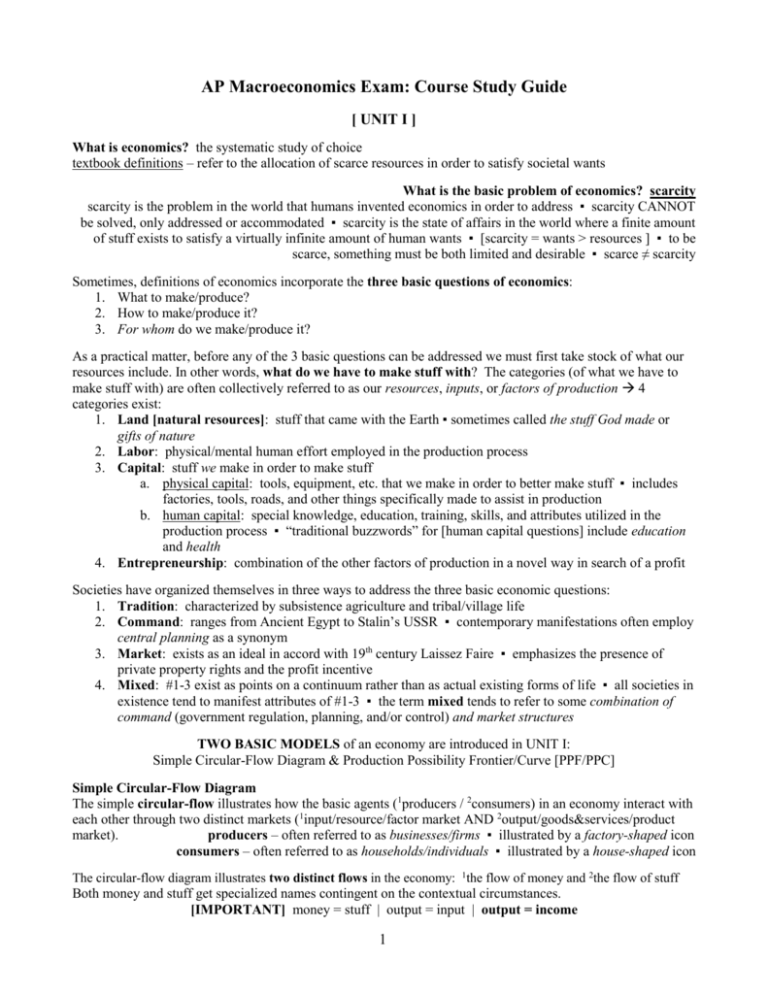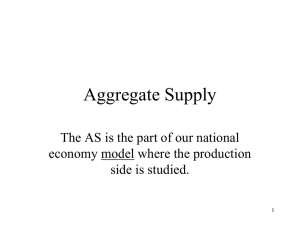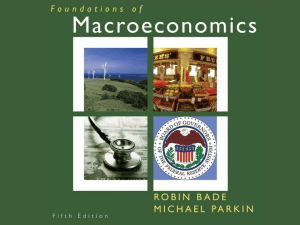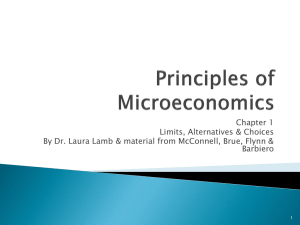AP Macroeconomics Exam/Course Study Guide
advertisement

AP Macroeconomics Exam: Course Study Guide [ UNIT I ] What is economics? the systematic study of choice textbook definitions – refer to the allocation of scarce resources in order to satisfy societal wants What is the basic problem of economics? scarcity scarcity is the problem in the world that humans invented economics in order to address ▪ scarcity CANNOT be solved, only addressed or accommodated ▪ scarcity is the state of affairs in the world where a finite amount of stuff exists to satisfy a virtually infinite amount of human wants ▪ [scarcity = wants > resources ] ▪ to be scarce, something must be both limited and desirable ▪ scarce ≠ scarcity Sometimes, definitions of economics incorporate the three basic questions of economics: 1. What to make/produce? 2. How to make/produce it? 3. For whom do we make/produce it? As a practical matter, before any of the 3 basic questions can be addressed we must first take stock of what our resources include. In other words, what do we have to make stuff with? The categories (of what we have to make stuff with) are often collectively referred to as our resources, inputs, or factors of production 4 categories exist: 1. Land [natural resources]: stuff that came with the Earth ▪ sometimes called the stuff God made or gifts of nature 2. Labor: physical/mental human effort employed in the production process 3. Capital: stuff we make in order to make stuff a. physical capital: tools, equipment, etc. that we make in order to better make stuff ▪ includes factories, tools, roads, and other things specifically made to assist in production b. human capital: special knowledge, education, training, skills, and attributes utilized in the production process ▪ “traditional buzzwords” for [human capital questions] include education and health 4. Entrepreneurship: combination of the other factors of production in a novel way in search of a profit Societies have organized themselves in three ways to address the three basic economic questions: 1. Tradition: characterized by subsistence agriculture and tribal/village life 2. Command: ranges from Ancient Egypt to Stalin’s USSR ▪ contemporary manifestations often employ central planning as a synonym 3. Market: exists as an ideal in accord with 19th century Laissez Faire ▪ emphasizes the presence of private property rights and the profit incentive 4. Mixed: #1-3 exist as points on a continuum rather than as actual existing forms of life ▪ all societies in existence tend to manifest attributes of #1-3 ▪ the term mixed tends to refer to some combination of command (government regulation, planning, and/or control) and market structures TWO BASIC MODELS of an economy are introduced in UNIT I: Simple Circular-Flow Diagram & Production Possibility Frontier/Curve [PPF/PPC] Simple Circular-Flow Diagram The simple circular-flow illustrates how the basic agents (1producers / 2consumers) in an economy interact with each other through two distinct markets (1input/resource/factor market AND 2output/goods&services/product market). producers – often referred to as businesses/firms ▪ illustrated by a factory-shaped icon consumers – often referred to as households/individuals ▪ illustrated by a house-shaped icon The circular-flow diagram illustrates two distinct flows in the economy: 1the flow of money and 2the flow of stuff Both money and stuff get specialized names contingent on the contextual circumstances. [IMPORTANT] money = stuff | output = input | output = income 1 Input/Resource/Factor Market: Households/individuals/consumers are the owners of the factors of production and exchange them for money. The money households/individuals/consumers receive is collectively called income. From the perspective of the firms/businesses, this money is collectively called factor payments. Each factor of production has a specific name for its payment: payments for… are called… land = rent labor = wages & salaries capital = interest entrepreneurship = profit Output/Goods&Service/Product Market: Households/individuals/consumers take their income earned through their participation in the factor market and exchange it for goods and services in the product market. What they purchase is called goods & services and the money they spend is called household/consumer expenditures. The money from the perspective of firms is called revenue. From the perspective of the firms, the inputs are combined through the production process adding value along the way and converting it into goods & services. [Historical Note] The big-picture idea illustrated through the simple circular-flow is that production exists in order to generate income. The relationship was understood as income exists to generate production in the 19th century. The difference in perspective represents our cultural belief in consumer sovereignty. The Simple Circular-Flow Diagram: Product, Output, Goods & Service Market $ $ Businesses Firms Producers “I” $ Input, Resource, Factor Market 2 Land Labor Capital Entrepreneurship Households Individuals Consumers “C” Rent Wages & Salaries Interest Profit Production Possibilities Frontier/Curve Production possibilities curves illustrate the limits of what is possible to produce for an economy if all resources are fully employed. A PPC illustrates the possible combinations of output available to an economy and addresses the basic economic question of what to make. Five types of PPC curves could be drawn, illustrating the trade-offs and types of opportunity costs involved in production. Important vocabulary that fits here: opportunity cost & trade-off These are related, but NOT synonymous words. Trade-offs are analogous to the possibilities represented to the curve before a decision is made and the opportunity cost can be measured after the decision has been made. This PPC illustrates no relationship between Good A and Good B This PPC also illustrates no relationship between Good A and Good B but merely shifts the axes. We define opportunity cost as “the next best thing”, but text definitions tend to involve what was forgone or alternative use of the common inputs. THREE TYPES OF PPC CURVES could be drawn: Increasing Opportunity Cost Curve bowed-out or concave to the origin Constant Cost Curve looks like: a right triangle Decreasing Opportunity Cost Curve looks like: a ski-jump Most PPC curves will be of this type. As more of one good is made, it entails an increasing cost in terms of the other good forgone. This is a less common but possible variety of PPC. The ratio of exchange between good A and good B is a constant. These are NOT possible!!! NEVER pick this as an example… even Harry Potter could not make this happen. 3 Production Possibilities Curves (cont.): We distinguish THREE TYPES OF POINTS on a PPC: A. Any point just inside the PPC is understood to be characteristic of an economy “not fully employing all factors of production at the highest level of technology.” More simply put, the economy is not using everything it has as best it can – it is inefficient. B. Any point on the PPC curve is understood to be characteristic of an economy “fully employing all factors of production at the highest level of technology.” – using everything it has as best it can, or efficiently. Economists cannot distinguish any point on the curve as preferable to another without more contextual information often in the form of normative preferences. Positive economic analysis requires economists to consider all points on the curve as equal in so far as they are all efficient. C. Any point outside of the curve is considered desirable (because more is better), but not possible, given current levels of factors of production and technology, alone. The “comma alone” is an important device to remind students that through the specialization of production based on lowest opportunity cost (comparative advantage) and exchange with another economy (trade), a consumption possibility can be achieved beyond what is possible alone (autarky). K. This point represents a level of extreme inefficiency characteristic of a severe recession, depression, and/or market failure. We use “K” to indicate that this is a setting when Keynesian economics is most likely to be appropriate. Increases are graphically expressed as a shift to the right such as, PPC1 to PPC2. + factors of production - costs of production + technology Decreases are graphically expressed as a shift to the left, such as PPC1 to PPC2. - factors of production + costs of production - technology 4 Basic SUPPLY and DEMAND GRAPHS are a vital component of UNIT I: DEMAND 1. 2. 3. 4. 5. 6. Increase Demand (Shift D Right) Decrease Demand (Shift D Left) D P (P1-P2) Q (Q1-Q2) D P (P1-P2) Q (Q1-Q2) Increase in the # of consumers Increase in income Increase in expectations of future price Increase in taste (advertising) Increase in the price of a substitute good Decrease in the price of a complementary good 1. 2. 3. 4. 5. 6. Decrease in the # of consumers Decrease in income Decrease in expectations of future price Decrease in taste (advertising) Decrease in the price of a substitute good Increase in the price of a complementary good SUPPLY 1. 2. 3. 4. 5. 6. Increase Supply (Shift S Right) Decrease Supply (Shift S Left) S P (P1-P2) Q (Q1-Q2) S P (P1-P2) Q (Q1-Q2) Increase in the # of producers Increase in the # of inputs Increase in technology Decrease in the cost of production (Increase in quality of inputs) Decrease in government regulation and/or taxes Positive exogenous supply shock (acts of God/OPEC) 1. 2. 3. 4. Decrease in the # of producers Decrease in the # of inputs Decrease in technology Increase in the cost of production (Decrease in quality of inputs) 5. Increase in government regulation and/or taxes 6. Negative exogenous supply shock (acts of God/OPEC) * Supply is really only effected by change in # of inputs, cost of inputs, and technology. * Change in price results in a change in quantity demanded or quantity supplied. Don’t fall for it. 5 [ UNIT II ] Hello, my name is Macroeconomics. Macroeconomics: the study of a nation’s economy as a whole (UNIT II introduces all of the basic Macro lingo and measures.) AP Macroeconomics has a total of 5 IDEAS: 1. Output 2. Inflation (often substituted in practice by ΔPL) 3. Unemployment 4. Growth 5. Trade OUTPUT: Basic measure of output = real Gross Domestic Product (rGDP) GDP: the total market value of all final goods and services produced in an economy in a given year nominal GDP: the total market value of all final goods and services produced in an economy in a given year ▪ this is the simple measure of P•Q, or [the number of goods times their price] *** rGDP: the total market value of all final goods and services produced in an economy in a given year, adjusted for change in price rGDP per capita: the total market value of all final goods and services produced in an economy in a given year, adjusted for change in price and divided by the (#) population ▪ this is the best measure to evaluate standard of living in an economy, across economies, or in an economy over time ▪ Functionally, it is still just a mathematical average and does not speak to the actual distribution of wealth/income in a society. rGDP is the measure we employ most often in class to refer to real output, but we have many synonyms and identities: rGDP = C + I + G + Nx = rent + wages&salaries + interest + profit = RNI, and sorta = AE = AD We have TWO WAYS to COUNT rGDP: 1. [The Income Approach] The income approach simply adds rent + wages&salaries + interest + profit. ▪ Keynesian economics is most interested in the manipulation of income and demand, and this is their method of choice. ▪ In fact, the preferred Keynesian term for output is Real National Income (RNI) and, their primary emphasis for policy is to manipulate Aggregate Expenditure (AE). 2. [The Expenditure Approach] THIS IS OUR METHOD!!! ▪ Consumption expenditures + planned/autonomous/private Investment expenditures + Government expenditures on production + Net export expenditures [exports (x) – imports (m)] ▪ Use the memorized definition of rGDP above as a filter to determine what is counted as rGDP and how it is counted. a. consumption: includes final purchases of all new goods and services produced in an economy in a given year b. government: excludes transfer payments since they are simply a transfer of money from one person to another without any actual production occurring c. investment: This is part of our most important idea in the class. ▪ We refer to all “I” as purchasing capital “K” which is a seed for future growth ▪ (victory > truth) ▪ (new houses and increases in inventories count as I) d. net exports: just (x – m) [Things that do not count, but are often in questions include]: non-market production, such as household production and black market production, intermediate goods included in the final price, and pure financial transactions, such as transactions including stocks/bonds, etc. 6 INFLATION: the rate of the increase in the overall average price level Price indexes are used to calculate changes in price level (inflation). Consumer Price Index (CPI): uses a constant quantity of goods, often referred to as a market basket of goods and compares their prices over time ▪ base year CPI value is always 100 [Basic CPI Formula]: [Basic formula for determining % change between two CPI values or other numbers]: GDP deflator is a similar tool used to determine real changes in GDP. Rather than constant quantities (baskets of goods) and changing prices over time, it employs constant (base year prices) and multiplies them times the changes in output. GDP deflator is employed to provide changes in rGDP. [Unemployment]: (Other rates called for could be labor force participation rate, employment rate, etc.) TWO CRITERIA must be met to be considered unemployed: 1. NOT have a job 2. Be looking for a job – (Other technical stuff about over 16, not institutionalized/military, etc. also exists in the definition but not in our practical definition.) 4 TYPES OF UNEMPLOYMENT: 1. Seasonal: not likely the answer ▪ [If you cannot figure out what this is, you should (insert sarcastic joke here).] 2. Frictional: this type of unemployment relates to physical or metaphorical movement ▪ people that physically move from one place to another ▪ recent graduates ▪ marriage/divorce ▪ all big life changes and moves could relate to this assuming no job and looking 3. Structural: the mismatch between jobs and skills within a society ▪ robot took my job 4. Cyclical: unemployment that is related directly to changes in the business cycle ▪ this is the ONLY type of unemployment that is EVER influenced by policy (fiscal and/or monetary) Discouraged workers: people without jobs that have given up looking for work [Methods of counting UE]: asking people through surveys/phone calls ▪ door-to-door census procedures; people tend to report, “Yeah, I’m looking.” Output and unemployment are inversely related to each other. As output goes up, more workers are required and vice versa. If an FRQ asks for ΔrGDP or ΔUE in its own letter, the answer must be explained through this relationship: More jobs leads to more output, etc… 7 [ UNIT III ] Fiscal Policy [involves the taxing and spending policies of Congress] Automatic Fiscal Policy: (often called automatic fiscal policy stabilizers) These are policies/laws that are on the books and are activated automatically by circumstances in the economy in a counter-cyclical way to stabilize the economy. These function to “tame the business cycle.” [examples include]: the progressive income tax system ▪ most all transfer payments – but specifically social security and unemployment insurance Discretionary Fiscal Policy: requires new legislation on the part of Congress in response to specific economic conditions ▪ characterized by an insufferable long internal lag but a virtually nonexistent external lag ▪ can ONLY ever effect AD directly EXPANSIONARY CONTRACTIONARY Increase Government Expenditures (G) Decrease Government Expenditures Decrease Income Taxes (Tincome) (G) Increase Income Taxes (Tincome) Decrease Corporate Taxes (Tcorporate) Increase Corporate Taxes (Tcorporate) Aggregate Demand / Aggregate Supply (AD/AS) Analysis AD/AS graphs can illustrate three conditions in an economy that correspond roughly with a, b, c on PPC: not fully employing all factors of production at the highest level of technology – inefficient fully employing all factors of production at the highest level of technology – efficient desirable but not possible given current levels of factors of production and technology, alone [problem of]: high unemployment low output recession [long-run equilibrium]: full employment (FE) potential output (Y*) natural rate of UE (NAIRU) 0% cyclical UE not sustainable given current levels of factors of production and technology overheating INFLATION PROBLEM Graph A Y1 < FE Graph B Y* = FE 8 PROBLEM Graph C Y1 > FE Long-Run Aggregate Supply (LRAS) and PPC LRAS and PPC are the same thing and are both moved by the same things: 1. Changes in # of factors of production 2. Changes in $ of factors of production 3. Changes in technology FISCAL POLICY AD/AS SOLUTION GRAPH C FISCAL POLICY AD/AS SOLUTION GRAPH A growth: graphically expressed by shifting LRAS or PPC to the right EVERYTHING IN THIS CLASS IS SUBORDINATE IN IMPORTANCE TO GROWTH!!! “Story of I” is the Story of Growth: I buys K; increase I » increase K » increase AS » increase stock of K » LRAS (positive economic growth) [Negative growth is the same sequence of events with decrease instead of increase.] AD = C + I + G + Nx AD = C + I + G + Nx … therefore, an increase in one of these components will increase AD. An increase in AD is graphically expressed as a shift to the right with a corresponding increase in price level (P1 – P2), increase in rGDP (Y1 – Y* ), and decrease in UE (Y1 –FE ). letter chains for Expansionary Discretionary Fiscal Policy Solution (implemented to address low output/high unemployment) … therefore, a decrease in one of these components will decrease AD. A decrease in AD is graphically expressed as a shift to the left with a corresponding decrease in price level (P1 – P2), decrease in rGDP (Y1 – Y* ), and increase in UE (Y1 –FE ). letter chains for Contractionary Discretionary Fiscal Policy Solution (implemented to address inflation) PL (P1-P2) G AD rGDP (Y1-Y*) UE (Y1-FE) PL (P1-P2) Tincome DI C AD rGDP (Y1-Y*) UE (Y1-FE) PL (P1-P2) Tcorporate I AD rGDP (Y1-Y*) UE (Y1-FE) PL (P1-P2) G AD rGDP (Y1-Y*) UE (Y1-FE) PL (P1-P2) Tincome DI C AD rGDP (Y1-Y*) UE (Y1-FE) PL (P1-P2) Tcorporate I AD rGDP (Y1-Y*) UE (Y1-FE) [multipliers related to taxing and spending]: basic concept – spending (consumption) becomes somebody else’s income, which is in turn split between further consumption and saving Disposable Income (DI) is split between consumption and spending. The fraction of the next bit of income that is spent is called MPC, whereas the fraction of the next bit of income that is saved is called MPS. G bigger ▪ G is a direct component of AD T smaller because it affects DI and loses some of its initial effect to savings (leakage to savings) 9 [ UNIT IV ] Monetary Policy The FED is the name of the central bank in the U.S. ▪ It is NOT part of the government or a government agency and does not receive 1 single dollar from the government for its operations. ▪ The government has some oversight regarding its operation through the Chairman of the FED, but the FED is NOT the GOV!!! The focus of monetary policy is captured by the ambiguous phrase: price stability. ▪ The FED attempts to promote price stability by keeping inflation in check and provide sufficient MS in order to facilitate a sustainable rate of growth. ▪ The FED and monetary policy can only ever affect the Money Supply (MS). ▪ MS then interacts with MD, resulting in an interest rate change. ▪ Money demand is independent of all FED activity. ▪ THREE distinct TYPES of MD exist: 1 transactions demand, 2precautionary demand, and 3speculative demand. ▪ These three demands are related to the THREE FUNCTIONS of MONEY: 1medium of exchange, 2unit of account, and 3store of value. Money has a number of PROPERTIES, as well, including durability, divisibility, acceptability, and many others in the Mort worksheet on money. Although the Treasury department prints money, money is actually created through the Deposit Expansion Multiplier Process. ▪ The FED is in charge of regulating the rate of the growth of the supply of money. Money Supply refers to M1, the stock of money— high power money. ▪ Money that is not as liquid is assigned higher numbers than 1, such as M2. ▪ These distinctions are more or less irrelevant for our class. ▪ M1 is the variety of money acceptable at Publix and includes demand deposits (checking accounts) + other demand deposits (other checking accounts) + currency & coin (cash) + traveler’s checks. ▪ The ratios are roughly 50% checks, 49% cash, and 1 % traveler’s checks. Monetary Policy FRQs come in TWO VARIETIES: Three L’s and Win & “Behroz Makes a Deposit” MONETARY POLICY SOLUTION GRAPH A Three L’s and Win: OMO buy MS r discount rate MS r , , r I , (the decrease in r leads to an increase in the quantity of interest sensitive investment demanded) B RR MS r C r I (the decrease in r leads to an increase in the quantity of interest sensitive investment demanded) A 1 , , r I , (the decrease in r leads to an increase in the quantity of interest sensitive investment demanded) 10 I AD PL (P1-P2) rGDP (Y1-Y*) UE (Y1-FE) E (Y1-FE) I AD PL (P1-P2) rGDP (Y1-Y*) UE (Y1-FE) E (Y1-FE) I AD PL (P1-P2) rGDP (Y1-Y*) UE (Y1-FE) E (Y1-FE) MONETARY POLICY SOLUTION GRAPH C OMO sale MS r r I , (the increase in r leads to a decrease in the quantity of interest sensitive investment demanded) A discount rate MS r 2 , , r I , (the increase in r leads to a decrease in the quantity of interest sensitive investment demanded) B RR MS r C , r I , (the increase in r leads to a decrease in the quantity of interest sensitive investment demanded) I AD PL (P1-P2) rGDP (Y1-Y*) UE (Y1-FE) E (Y1-FE) I AD PL (P1-P2) rGDP (Y1-Y*) UE (Y1-FE) E (Y1-FE) I AD PL (P1-P2) rGDP (Y1-Y*) UE (Y1-FE) E (Y1-FE) We label the money market’s vertical axis as interest rate and “r” rather than nominal interest rate and “i” as a tactic – unless some compelling reason in the question exists to do otherwise. This facilitates the linkage between the first and second L’s. “Behroz Makes a Deposit”: Step #1: Is the deposit a shift within the composition of MS or is it an infusion of new money in the system? Step #2: Find out the required reserve ratio (RR) and determine the amount of required reserves. Step #3: Does the question indicate anything about preexisting reserves or excess reserves? Step #4: Make a chart that is an identity of all of the basic terms explicit and implicit in the question. Step #5: Calculate the effect of the deposit from this one bank and the maximum effect on the entire MS. Step #6: Be prepared to list the three limitations that could have kept the MS from reaching its maximum if they were not already incorporated in the question. 11 Behroz deposits $1,000 in cash into Happy Bank. The reserve requirement is 20%. Happy Bank has no excess reserves. a. b. c. d. a. What is the immediate effect on the MS? What is the maximum increase on MS that can be made by Happy Bank? What is the maximum effect on the MS by the entire banking system? Why won’t the MS be increased by its theoretical maximum amount? No immediate change in the quantity of the money supply, but its composition will shift to relatively less cash and relatively more demand deposits. MS = Cash -$1,000 + Demand Deposits +$1,000 + Traveler’s Checks … therefore, no change in MS. b. RR = 20% | $1,000 • 0.20 = $200 | $1,000 [deposit] – $200 = $800 [excess reserves available to loan] c. [Method 1] (initial deposit • multiplier) – initial deposit [ $1,000 • 5 = $5,000 – $1,000 = $4,000 ] [Method 2] initial loan • multiplier [ $800 • 5 = $4,000 ] Method 1is preferred because it requires the student to double-check if the initial deposit was a shift within MS or a new infusion of high-power money. d. if banks keep excess reserves, every dollar held in excess reserve represents [1 • multiplier dollars], not expanded if people hold money in the form of cash rather than redeposit funds the banks offer loans but customers are unwilling to take out loans at prevailing market rates. [Other Monetary Stuff]: OMOs are undertaken every business day and considered to have a precise/fine tuning capability by monetary policy advocates. The discount window represents the portal through which the FED acts as a lender of last resort for banks in trouble. ▪ Negative social stigma is attached to using the discount window. Changes in the required reserve ratio/reserve requirement (RR) are considered to be as precise as surgery with a chainsaw and predictable as the geometry of a snowflake. Federal funds rate is the rate at which banks lend money to other banks for short term loans. ▪ another example: tricky language associated with monetary policy MV = PQ M = M1 = MS = stock of money V = income velocity of money P = average overall price level= GDP deflator Q = rGDP PQ = nominal GDP Winners and Losers from unanticipated inflation: People that pay with inflated money (TP) win those that get inflated money lose. Fixed income(contractors), Savers and Lenders are big losers; Borrowers, debtors, and mostly U.S. Gov “win”. [ UNIT V ] Monetary and Fiscal Policy Interactions fiscal policy has long internal lag and short external lag monetary policy has short internal lag and long/indeterminate external lag the BIG IDEA is that fiscal and monetary policy have opposite effects on interest rates that leads to crowding out/crowding in 12 Expansionary Fiscal/ Budget Deficit Scenario [The Arguments for Crowding Out]: (A) MD 1 (B) MD Crowding out is an unintended consequence of expansionary fiscal policy. For simplicity’s sake, assume that each of the following scenarios follows: PL (P1-P2) G AD rGDP (Y1-Y*) E (Y1-FE) UE (Y1-FE) In order to purchase the new greater quantity (Y*) at the new higher prices (P2), there is an increase in the transactions demand for money. MD r , r I , I AD PL (P1-P2) rGDP (Y1-Y*) (the increase in r leads to E (Y1-FE) a decrease in the quantity UE (Y1-FE) of interest sensitive investment demanded) The final position of AD is between AD1 and AD2. [ rGDP = RNI ] rGDP RNI MD r , r I , I AD (the increase in r leads to a decrease in the quantity of interest sensitive investment demanded) The final position of AD is between AD1 and AD2. PL (P1-P2) rGDP (Y1-Y*) E (Y1-FE) UE (Y1-FE) (A) 2 DLF OUR WAY G deficit DLF r Financing I AD PL (P2-P3) rGDP (Y1-Y*) E (Y* - Y3) (the increase in r leads to UE (Y* - Y3) a decrease in the quantity of interest sensitive investment demanded) The final position of AD is between AD1 and AD2. , 13 r I , [Crowding Out]: (cont.) (B) 2 SLF THE “TRUTH” G deficit SLF r , r I , I AD Financing (the increase in r leads to a decrease in the quantity of interest sensitive investment demanded) The final position of AD is between AD1 and AD2. PL (P1-P2) rGDP (Y1-Y*) E (Y1-FE) UE (Y1-FE) The monetary authority/central bank/FED is monitoring the economy and will sometimes act to prevent the unintended consequences of fiscal policy through what is called accommodating or reinforcing monetary policy. Essentially, this means enacting a monetary policy to minimize the interest rate effect of the fiscal policy in question. [Crowding In: Our Way] Contractionary Fiscal/ Budget Surplus Scenario Crowding in is an unintended consequence of contractionary fiscal policy. PL (P1-P2) G rGDP (Y1-Y*) AD E (Y1-FE) UE (Y1-FE) (A) 2 DLF OUR WAY G deficit DLF r Financing I AD PL (P1-P2) rGDP (Y1-Y*) E (Y1-FE) (the decrease in r leads UE (Y1-FE) to a increase in the quantity of interest sensitive investment demanded) The final position of AD is between AD1 and AD2. , 14 r I , The “Crowding In” scenario is listed as a matter of symmetry for our Crowding Out discussion. Any government activity that induces (mal)investment from the private sector could result in a Crowding In scenario. We prefer the symmetrical scenario detailed above for simplicity’s sake where victory > truth. Mankiw discusses the effects when the government intervenes in the market in such a way that result in an increase in private-sector investment, mainly on fixed inputs (capital, such as a factory). This occurs because government spending increases the demand for goods and services (G AD), which results in higher business optimism (when business see that more people are buying their products, they are more optimistic about producing more of that product), and the demand for new output sources by businesses (capital is a source of output; it makes stuff; stuff is output) increases. New output sources are demanded because people are buying more stuff (due to government spending), and to meet this new demand, businesses need to invest (buy) the stuff that makes the goods and services that people are willing to pay for. Businesses are buying capital (stuff that makes stuff), which is an increase in investment (I). This idea is different from crowding out, which states that expansionary fiscal policy (G) results in a decrease in investment. Crowding in states that expansionary fiscal policy (G) results in an increase in investment. EXPANSIONARY CONTRACTIONARY EXPANSIONARY CONTRACTIONARY MONETARY POLICY FISCAL POLICY The BIG Picture of Fiscal/Monetary Policy AD PL rGDP UE E r G Tincome Tcorporate G Tincome Tcorporate OMO buy discount reserve requirement OMO sale rate discount rate reserve requirement 15 potential crowding out potential accommodating monetary policy [ UNIT VI ] International Economics r in county X r in the U.S., relative to country X capital outflow from country X OR capital inflow to the U.S. r in county X r in the U.S., relative to country X capital inflow to country X OR capital outflow from the U.S. demand for dollar denominated financial assets demand for dollar denominated financial assets 16 D$ D$ appreciation of the US$ relative to the X$ from (e1 – e2) depreciation of the US$ relative to the X$ from (e1 – e2) [Typical International Goods (Current Account) Question]: [HINT] If forced to use S$, it should respond to ΔrGDP. [TRUTH] Goods questions are S$. Appreciation of the $ relative to the from e1 –e2 Depreciation of the $ relative to the from e1 –e2 PL in U.S. ($) PL in U.S. ($) $ denominated goods become relatively more expensive » D$ [truth » ( denominated goods become relatively less expensive) $ denominated goods become relatively less expensive » D$ [truth » ( denominated goods become relatively more expensive) $ denominated goods become relatively more expensive » D$ [truth » ( denominated goods become relatively less expensive) $ denominated goods become relatively less expensive » D$ [truth » ( denominated goods become relatively more expensive) X S$] M X S$] M X S$] M X S$] M [Flow of Goods and Services]: CAUSE EXPLANATION EFFECT PL: The increase in price level makes PL in the U.S – country you are looking at Appreciation of $ – value of the currency you are looking at PL in – the other country Depreciation of – value of the other country’s currency PL in the U.S – country you are looking at Depreciation of $ – value of the currency you are looking at PL in – the other country Appreciation of – value of the other country’s currency. dollar denominated goods relatively more expensive. Appreciation here: The appreciated $ makes dollar denominated goods relatively more expensive. PL in other country: The decrease in price level makes denominated goods relatively less expensive. Depreciation of : The depreciated makes denominated goods relatively less expensive. PL: The decrease in price level makes dollar denominated goods relatively less expensive. Depreciation here: The depreciated $ makes dollar denominated goods relatively less expensive. PL in other country: The increase in price level makes denominated goods relatively more expensive. Appreciation of : The appreciated makes denominated goods relatively more expensive. 17 Decrease in U.S. exports (X) Increase in U.S. imports (M) Increase in U.S. exports (X) Decrease in U.S. imports (M) EXPANSIONARY CONTRACTIONARY EXPANSIONARY G Tincome Tcorporate G Tincome Tcorporate OMO buy discount rate reserve requirement CONTRACTIONARY MONETARY POLICY FISCAL POLICY A Look-Ahead to Other International Consequences: [NOTICE] Your answer is different depending on whether it is a goods or financial assets question. OMO sale discount rate reserve requirement PL Goods/Current Account Value of the $ $ denominated goods become relatively more expensive D$ (truth S$) Depreciation of the $ relative to the from e1 – e2 $ denominated goods become relatively more expensive D$ (truth S$) Depreciation of the $ relative to the from e1 – e2 $ denominated goods become relatively more expensive D$ (truth S$) Depreciation of the $ relative to the from e1 – e2 $ denominated goods become relatively less expensive D$ (truth S$) Appreciation of the $ relative to the from e1 – e2 $ denominated goods become relatively less expensive D$ (truth S$) Appreciation of the $ relative to the from e1 – e2 $ denominated goods become relatively less expensive D$ (truth S$) Appreciation of the $ relative to the from e1 – e2 $ denominated goods become relatively more expensive D$ (truth S$) Depreciation of the $ relative to the from e1 – e2 $ denominated goods become relatively more expensive D$ (truth S$) Depreciation of the $ relative to the from e1 – e2 $ denominated goods become relatively more expensive D$ (truth S$) Depreciation of the $ relative to the from e1 – e2 $ denominated goods become relatively less expensive D$ (truth S$) Appreciation of the $ relative to the from e1 – e2 $ denominated goods become relatively less expensive D$ (truth S$) Appreciation of the $ relative to the from e1 – e2 $ denominated goods become relatively less expensive D$ (truth S$) Appreciation of the $ relative to the from e1 – e2 18 r Financial Assets/Capital Account Value of the $ demand for $ denominated financial assets in order to yield a higher return D$ appreciation of the $ relative to the from e1 - e2 demand for $ denominated financial assets in order to yield a higher return D$ appreciation of the $ relative to the from e1 - e2 demand for $ denominated financial assets in order to yield a higher return D$ appreciation of the $ relative to the from e1 - e2 demand for $ denominated financial assets in order to yield a higher return D$ depreciation of the $ relative to the from e1 - e2 demand for $ denominated financial assets in order to yield a higher return D$ depreciation of the $ relative to the from e1 - e2 demand for $ denominated financial assets in order to yield a higher return D$ depreciation of the $ relative to the from e1 - e2 demand for $ denominated financial assets in order to yield a higher return D$ depreciation of the $ relative to the from e1 - e2 demand for $ denominated financial assets in order to yield a higher return D$ depreciation of the $ relative to the from e1 - e2 demand for $ denominated financial assets in order to yield a higher return D$ depreciation of the $ relative to the from e1 - e2 demand for $ denominated financial assets in order to yield a higher return D$ appreciation of the $ relative to the from e1 - e2 demand for $ denominated financial assets in order to yield a higher return D$ appreciation of the $ relative to the from e1 - e2 demand for $ denominated financial assets in order to yield a higher return D$ appreciation of the $ relative to the from e1 - e2 Two Scenarios “Something that can…” Four Scenarios “Something that…” [Unit VII] Phillips Curve 1 2 1 2 3 4 PL UE PL AD UE PL AS UE PL AS UE AD natural rate of UE such as an UE compensation natural rate of UE such as a UE compensation inflation unemployment inflation unemployment inflation unemployment inflation unemployment right shift in LRPC from LRPC1 LRPC2 a b, along the curve a c, along the curve SRPC1 SRPC2 SRPC1 SRPC3 labor, capital, or land) (This is left shift LRAS) left shift in LRPC from LRPC1 LRPC3 (This is right shift LRAS) 19 explanation required (i.e. technology, stock of explanation required (i.e. technology, stock of labor, capital, or land) AP Macroeconomics BIG IDEA: TRADE IS GOOD! 1. Trade is a non-zero sum game through which participants specialize based on their comparative advantage [lowest opportunity cost] and exchange goods and services. The results include: a. a consumption possibility through trade greater than what could be achieved through autarky [production alone without trade/self-sufficiency] b. a higher standard of living in both countries – [same as a.] c. more efficient allocation of productive resources in both countries ▪ greater efficiency in both countries 2. Consequences of trade barriers: a. a consumption possibility less than what could be achieved through trade b. a lower standard of living in both countries – [same as a.] c. less efficient allocation of productive resources in both countries ▪ less efficiency in both countries 3. A few words on PROTECTIONISM a. ALL protectionist policies have serious consequences as listed above in #2 “Consequences of trade barriers” b. Trade barriers are only justifiable on political/value-based grounds. Two circumstances tend to exist for trade barriers despite the myriad of different seeming circumstances. i. A mode of production vital to national interests and/or the common good of a people require protection and/or significant government regulation inhibiting free trade. ii. A powerful lobby utilizes the mechanisms of government to protect them against competition. This is functionally a conspiracy against the national interests/common goods through the complicity of government. [Typical Absolute/Comparative Advantage Questions]: 1. Absolute advantage is simply who can make more with the same # of resources, time, or other common denominator. Atlantis has absolute advantage because X > Y, with the same resources. 2. Absolute advantage can be held by one player in both goods, both players in one good, and one player in zero goods. 3. Comparative advantage means lowest opportunity cost – whoever gives up the least Y per unit X produced has absolute advantage in X. 4. Comparative advantage cannot be held in both goods or zero goods. It must be split between the players (law of MATH). A possible exception is if both countries have exactly the same production possibility curves for both goods a very unlikely question prompt. 5. [Input/Output Method] This is a FALSE dichotomy. There is only an output method – absolute and comparative advantages are always referring to products. Some questions present the data in the form of some factor/input, such as units of farmland, time, etc. Do not fall for the trick. If you do not recognize whether or not the original data of the question is input or output, you run the risk of having the opposite answer. The supposed input method is simply taking the data provided and turning it into how much stuff each player can make. 20 Output (Product Market) Input (Factor Market) (assume with same amount of resources) (assume hours per 1 unit of goods) Atlantis: 10 guns or 20 butter Xanadu: 2 guns or 10 butter Atlantis has absolute advantage in guns because 10 > 2 with the same amount of resources. Atlantis has absolute advantage in butter because 20 > 10 with the same amount of resources. Atlantis can make 1 gun or 2 butter. Atlantis per/unit opportunity cost of 1G is 2B. Atlantis can make 1 butter or ½ gun. Atlantis per/unit opportunity cost of 1B is ½G. Xanadu can make 1 gun or 5 butter. Xanadu per/unit opportunity cost of 1G is 5B. Xanadu can make 1 butter or 1/5 gun. Xanadu per/unit opportunity cost of 1B is 1/5G. Atlantis has comparative advantage in guns because their opportunity cost per 1G is 2B and Xanadu’s opportunity cost per 1G is 5B. [2B < 5B] Xanadu has comparative advantage in butter because their opportunity cost per 1B is 1/5G and Atlantis’s opportunity cost per 1B is ½G. [1/5G < ½G] Atlantis should specialize in guns. Xanadu should specialize in butter. Atlantis: exports guns, imports butter. Xanadu: exports butter, imports guns Acceptable terms of trade must be better than autarky. Atlantis must get >2B per 1G. Xanadu must get >1/5G per 1B. … therefore, acceptable per unit terms of trade: Atlantis: exports 1G for imports >2B to <5B Xanadu: imports 1G for exports >2B to <5B Atlantis: imports 1B for exports <½G to >1/5G Xanadu: export 1B for import <½G to >1/5G If terms were 1G : 3B, what are benefits? Atlantis: gain 1 more B per unit G, alone Xanadu: cost 2 fewer B per unit G, alone Alpha: 10 hours per gun or 20 hours per butter Beta: 2 hours per gun or 10 hours per butter Beta has absolute advantage in guns because 1 > 1/5 in the same amount of time. Beta has absolute advantage in butter because 2 > 1 in the same amount of time. Alpha can make 1 gun or ½ butter. Alpha per/unit opportunity cost of 1G is ½B. Alpha can make 1 butter or 2 gun. Alpha per/unit opportunity cost of 1B is 2G. Beta can make 1 gun or 1/5 butter. Beta per/unit opportunity cost of 1G is 1/5B. Beta can make 1 butter or 5 gun. Beta per/unit opportunity cost of 1B is 5G. Alpha has comparative advantage in butter because their opportunity cost per 1B is 2G and Beta’s opportunity cost per 1B is 5G. [2G < 5G] Beta has comparative advantage in guns because their opportunity cost per 1G is 1/5B and Alpha’s opportunity cost per 1G is 1/2B. [1/5B < ½ B] Alpha should specialize in butter. Beta should specialize in guns. Alpha: exports butter, imports guns. Beta: exports guns, imports butter. Acceptable terms of trade must be better than autarky. Alpha must get >2G per 1B. Beta must get >1/5B per 1G. … therefore, acceptable per unit terms of trade: Alpha: exports 1B for imports >2G to <5G Beta: imports 1B for exports >2G to <5G Alpha: imports 1G for exports <½B to >1/5B Beta: exports 1G for imports <½B to >1/5B If terms were 1B : 3G, what are benefits? Alpha: gain 1 more G per unit B, alone. Beta: cost 2 fewer G per unit B, alone 21








